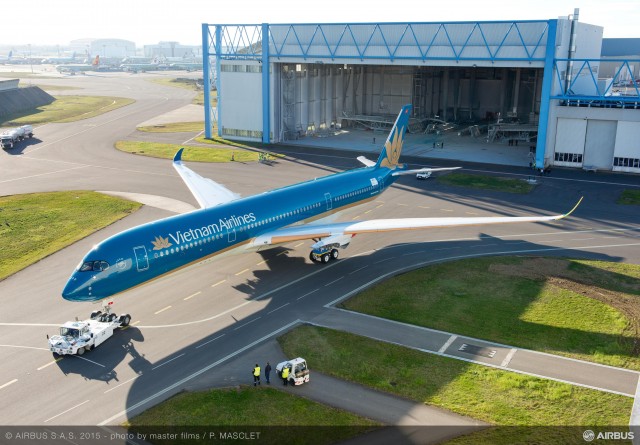
The initial A350 XWB for Vietnam Airlines rolled out of Airbus’ Toulouse paint shop on 6 March 2015, displaying the airline’s updated blue and gold lotus livery
Vietnam Airlines, the government-owned national flag carrier for Socialist Republic of Vietnam, is on the cusp of its first major international expansion in over a decade.
The airline has made no secret of its desire to become the second-largest carrier in Southeast Asia by 2020, behind Singapore Airlines. With the financial near-collapses of regional competitors Thai Airways and Malaysia Airlines and the upcoming expansion of its long-haul fleet, Vietnam Airlines is poised to gain significant market share and inch closer to its goal of regional domination.
A member of the SkyTeam alliance, Vietnam currently operates a full-service schedule to 52 destinations in 17 countries, with an active fleet of 77 aircraft.
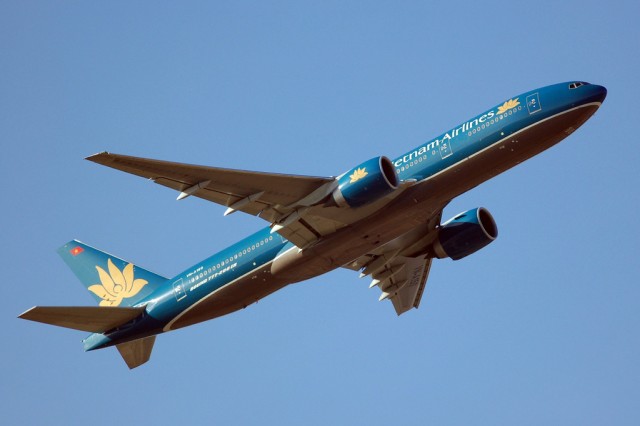
A Vietnam Airlines’ Boeing 777-200ER at Frankfurt – Photo: Thomas Becker
Current Wide-body Fleet and Destinations
Vietnam Airlines relies on 18 mostly-leased wide-body aircraft, including eight Boeing 777-200ERs and 10 Airbus A330-200s. Only four 777s are owned by the airline, the last of which was delivered in 2004.
The wide-body fleet primarily serves destinations in Europe, northern Asia, and the south Pacific, as well as on the trunk route between Hanoi’s Noi Bai Airport (HAN) to the north and Tan Son Nhat Airport (SGN) in the south’s Ho Chi Minh City (formerly known as Saigon), as tag-on re-positioning flights between the carrier’s two main hubs.
There is currently no service to Africa, the Middle East, or the Americas.
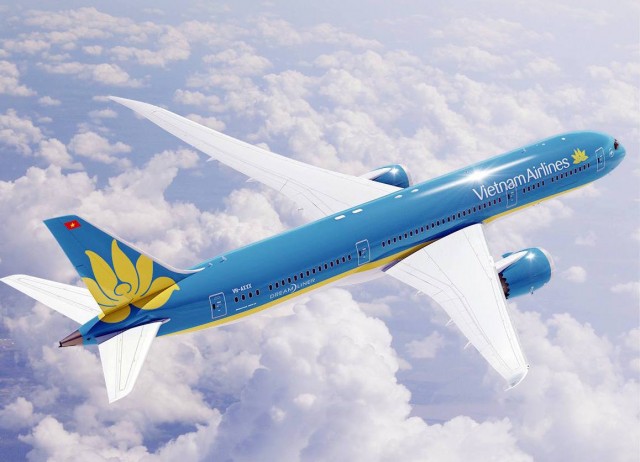
Rendering of new 787-9 in Vietnam Airlines’ new livery – Image: Vietnam Airlines
Revitalization of the Long-Haul Fleet
Vietnam Airlines’ fleet renewal and expansion plans calls for 33 new fuel-efficient long-range aircraft, split between 19 Boeing 787-9 Dreamliners and 14 Airbus A350-900s. The first of both types will be delivered this summer, and the carrier intends to replace its entire wide-body fleet by 2018, with an anticipated total fleet size of 100 by 2020.
Because of the manufacturing delays for both the 789 and A359, the airline has not expanded long-haul service since 2011. They cited the logistical problems of entering into short-term leases as backstops, and chose instead to delay service to new destinations until their new deliveries arrive.
The inaugural international flight for the 787-9 is expected to be on June 29 from HAN to London-Heathrow (LHR), followed by the first long-haul A350-900 flight from HAN to Paris (CDG) scheduled for September 30.
The 777-200ER has a range of only 6,200 nautical miles with 20% more fuel burn than its 787-9 cousin, which has a range of up to 8,500 nm. As such, the airline’s reach will be greatly expanded when the new aircraft come online, eliminating the need for refueling stops on the way to European destinations. They will also make nonstop flights from Vietnam to North America technically and financially feasible, though government and administrative hurdles currently prevent that from being possible.
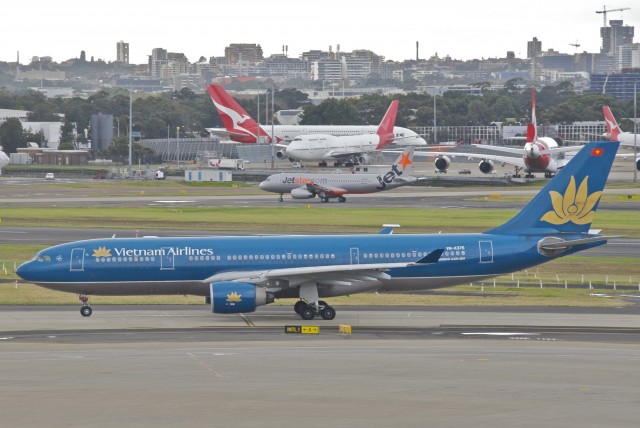
A Vietnam Airlines’ Airbus A330-200 in Sydney – Photo: Icarus | Flickr CC
Commencing Non-Stop Service to North America
Vietnam Airlines has repeatedly stated its desire to launch nonstop service to North America and its population of over 1.8 million Vietnamese-Americans and expatriates.
The primary hurdle to their plan is the Federal Aviation Administration (FAA), which allows foreign carriers into US airspace only if their respective civil aviation authorities are deemed safe enough to receive Category 1 (CAT-1) status, something the Civil Aviation Authority of Vietnam (CAAV) has not yet obtained from the FAA. Likewise, Canadian authorities have mirrored the FAA’s prohibition.
The CAAV, along with Boeing, recently pledged to make acquiring CAT-1 status a top national priority and work quickly to address the issues of airspace safety and agency oversight, which have been the main shortcomings cited. The FAA has also agreed to provide technical expertise and support to the CAAV.
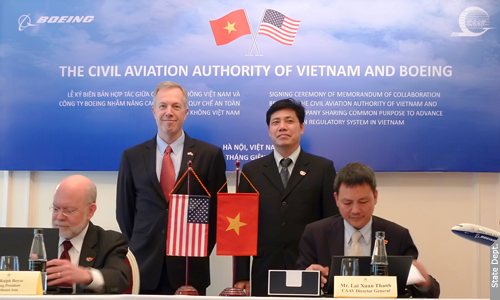
Memorandum of Cooperation signing ceremony between the CAAV and Boeing – Photo: US Department of State
Vietnam Airlines, in its recent initial public offering prospectus, declared its intention to commence nonstop service from SGN to Los Angeles (LAX) in 2016, a route made possible by the 787-9.
Other North American destinations mentioned include San Francisco, Washington DC, and Vancouver. Houston and Seattle are future potential destinations as well, due to their significant Vietnamese populations.
Currently, no other Vietnamese-flagged carriers offer long-haul service. Privately-held low-cost competitor VietJet Air has postponed plans to acquire wide-body long-range aircraft by at least three-to-five years.
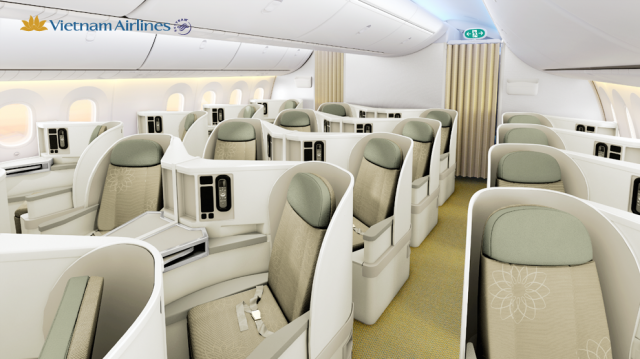
Rendering of the new business class cabin in the Boeing 787-9 – Photo: Vietnam Airlines
Wide-Body Passenger Experience
High-demand routes feature a three-class cabin configuration of business class, a premium economy product dubbed ’œdeluxe economy,’ and economy. Lower-demand and regional routes typically offer a two-class cabin; business and economy. As is common now with many carriers, Vietnam does not currently offer a first class cabin, nor has indicated any intention to do so in the future.
Seating up to 325 passengers, current wide-body aircraft offer basic audio/video-on-demand (AVOD) entertainment systems with limited selections. Modern niceties such as power adaptors, USB charging, and lie-flat seats in business class are not present in the current fleet, but those deficiencies will be addressed by the new aircraft.
With the introduction of the 787 and A350, seating between 211-283 passengers, the airline will bring its inflight features in-line with its global competitors. Passengers in all classes will be treated to universal power outlets, individual high-definition touchscreen AVOD entertainment, and available inflight WiFi access.
Their new business class seat on the 787 is similar to the seats used by Cathay Pacific, as well as Air France, American Airlines, EVA Air, and others. It features a reverse herringbone lie-flat design in a 1-2-1 configuration that provides aisle access to all 28 seats, as well as a measure of privacy. The business product comes complete with power plugs, storage bins, and a 15.4-inch screen.
The business seats on the A350 are of a different, staggered layout but also have similar features to their 787 counterparts. These seats can be found in the business cabins of Emirates, Korean Air, and Thai Airways, among others.
Economy passengers aren’t neglected, with 9-inch touchscreens and modern seats that maximize legroom.
Deluxe economy passengers in the 787s will be graced with larger seats that are similar to business class seats on domestic aircraft, featuring 10-15 degrees in recline, a leg rest, and a minimum of 38 inches of pitch. However, it seems that deluxe economy passengers on the A350 will merely have extra legroom in the same seats as the rest of the economy cabin.
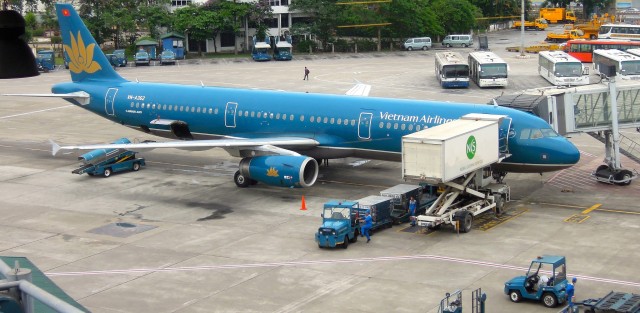
A Vietnam Airlines’ Airbus A321 seen at HAN – Photo: David McKelvey | Flickr CC
Bolstering the Narrow-body Fleet
While Vietnam Airlines has had a freeze on its expansion plans for long-haul routes and aircraft, it has been very busy shoring up its single-aisle fleet for domestic and regional operations.
The airline has turned to the Airbus A321 as its primary workhorse for the narrow-body fleet. The A321 is used primarily for domestic and lower-demand regional routes, flying as far as Japan. With 55 active and three to be delivered, the A321 has allowed the airline to retire older Fokker 70s, Airbus A320s and A321s, and achieve commonality for the bulk of the fleet, lowering overall maintenance and training costs as well as making aircraft swaps easier to manage.
The A321 cabin is configured into two classes, with 16 recliner seats in business and 168 standard seats in economy. The latest aircraft feature Airbus’ new interior with adaptive color-changing LED-lighting. Entertainment consists of overhead LCD video screens; power outlets are not available.
For lower-yield short-haul routes and airports that are too small for mainline service, Vietnam Airlines relies on a fleet of 16 ATR 72-500 turboprops configured with a simple all-economy cabin of 66 seats. The last ATR was delivered in 2011.
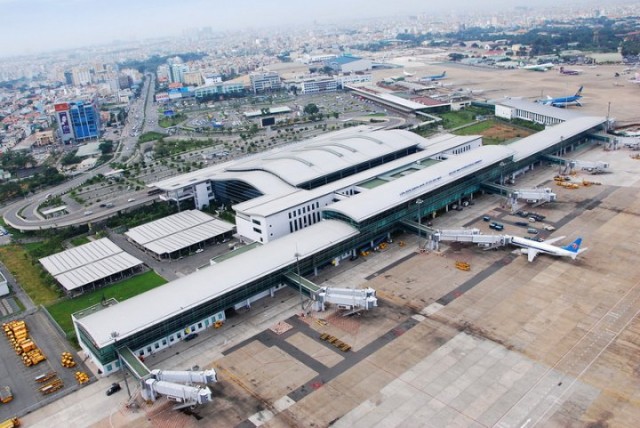
International Terminal at Tan Son Nhat International Airport (SGN) in Ho Chi Minh City – Photo: Airports Corporation of Vietnam.
Airport Hubs and Focus Cities
Vietnam Airlines’ main hubs and international gateways are northern HAN (also the location of their headquarters) and SGN to the south.
Da Nang (DAD) in central Vietnam is a focus city, with international and regional flights as well as being the third domestic hub for the airline. Nha Trang (CXR) and Phu Quoc (PQC) are other focus cities, with ever-increasing regional service.
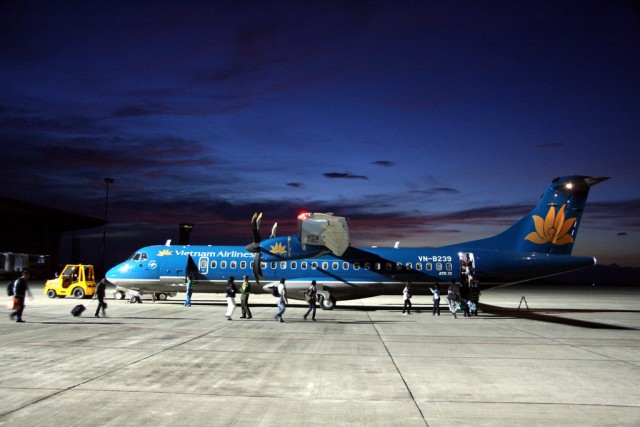
A Vietnam Airlines’ ATR 72 – Photo: Travel Aficionado | Flickr CC
Frequent Flyer Benefits
Vietnam Airlines recognizes frequent flyers through its Golden Lotus Plus (GLP) program, with three elite tiers that provide integrated global recognition and benefits through their membership in SkyTeam, a 20-member alliance. GLP’s currency is the ’œmile’ and is accrued as a function of distance flown and fare paid, with the lowest fares earning only 0.5 GLP miles per actual flight mile flown, while the most expensive fares earn as many as 2.5 GLP miles.
GLP Titanium is one of the easiest elite statuses to obtain within SkyTeam, granted after just 15,000 GLP miles earned within one year. This status allows access to SkyPriority check-in, security, and boarding lines, as well as priority for standby and rebooking situations and guaranteed seat availability on any Vietnam Airlines-operated flight.
Access to Vietnam Airlines’ airport lounges is granted after earning Gold status with 30K GLP miles, while SkyTeam partner lounge access requires Platinum status at 50K GLP miles.
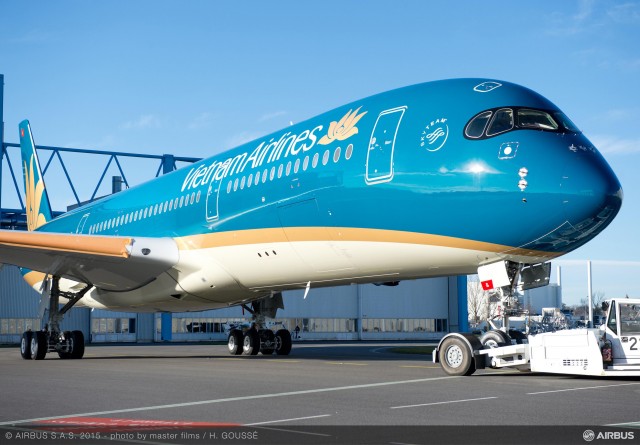
Vietnam Airlines’ first Airbus A350 recently rolled out of the paint hangar – Photo: Airbus
Keep Vietnam Airlines on Your Radar
The next five-to-ten years will certainly be very interesting for Vietnam Airlines and the overall airline industry in Southeast Asia. And don’t be surprised when you see a teal-and-gold lotus the next time you’re at LAX.
This story was written by John Nguyen (@VNAFlyer) for AirlineReporter
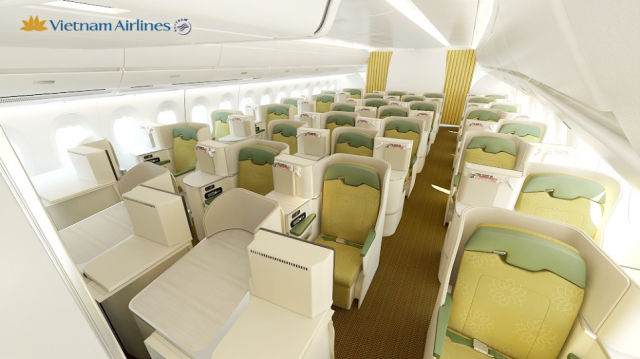
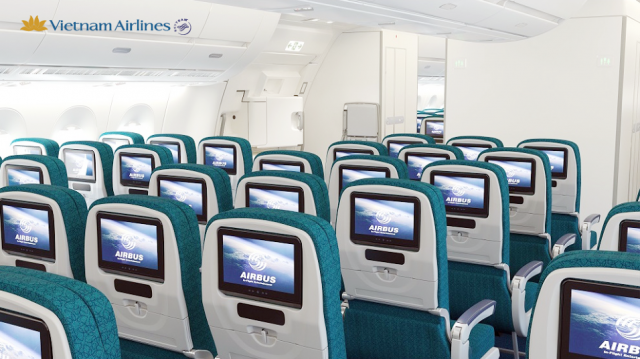
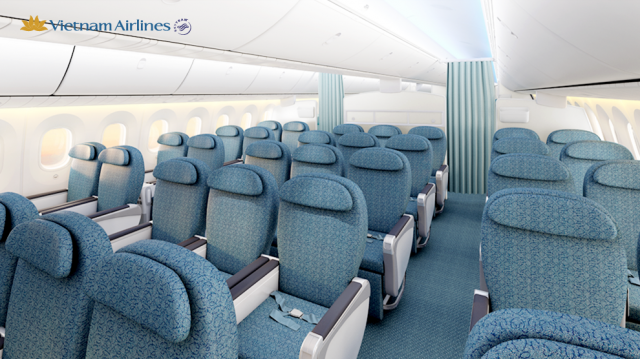
I had the chance to fly from TPE to HCMC, Hue, Hanoi, and back with TPE routes served by one of there former A340s in Economy. I thought that the service was good, FA wore traditional vietnamese outfits and the food was good. They had the right idea back then and it seems like they’ve been gaining momentum. Interesting development with their fleet modernization.
I flew them from HCMC to Hanoi and Hanoi to Shanghai Pudong. Very nice flights. I really like the idea of catching a direct flight to Vietnam rather than stopping elsewhere (I definitely want to go back for another vacation).
By the way, anyone here who flies to/from Hanoi … watch the far side of the runway. You’ll see a row of shelters with MiG-21s in them. I had no idea, so I didn’t have my camera out. I would’ve loved a photo.
They are a lovely carrier, gracious as any of the Asian carriers. It would be nice in these reviews to have pictures of the inflight service, cabin and pilot crews, and … people connected to this airline. They are up and coming for sure.
We hope to offer more about the airline, including reviews, in the future.
Cheers,
David, AirlineReporter
It would be awesome if you guys post some stories about Indian Aviation Industry. With so many new entrants from Vistara (Tata-SIA) and Airasia India, the story would rock!
The 350 and 787 look terrific in their colours!
Vietnam Airlines is in its new development as its home country Việt Nam. I have no doubts that it will become a top-notch air carrier in near future. Give it some time.
Thanks to John for a great, well written overview of Vietnam Airlines. I learned a few things. In fairness, I also like their current livery.
No matter the merits or demerits of this SEA-based airline, their wishes for international expansion and the costs associated with upgrading their fleet and safety maintenance standards, they still face some significant hurdles before they can fly to/from most of North Amerika. Of course they want to serve the noted 1.8 million souls of Vietnamese origin resident in the U.S., as well as many others. They may have a significant challenge, one well beyond fares and services, to capture much market share from senior and semi-senior Amerikans, especially males.
I’m well aware that the current Social Responsibility political correctness (PC) dictates that we forgive and forget much of the historical record. And, for some of us, particularly U.S. males between ~60 and 75, that simply may not be possible. The several younger generations may be more tolerant and more forgiving – and recall far less detailed experience than do (especially) men of my generation. To put it more succinctly, It Will be a Cold Day in Hell before I will patronize a Vietnam-owned airline for transportation anywhere, including Vietnam. No! No matter how fresh their growing long haul fleet or ow impressive their ‘soft product,’ I refuse to fly that airline and I never will. If/when they ever establish service between VN and the U.S., I suspect that their pax loads will include damn few Amerikan males of my generation.
Again, a great report and excellent pix of their current livery. I just won’t fly them, ever.
-C
Cook
If they can overcome our carpet bombing, napalm, and pointless war in THEIR country and buy lots of Boeing jets, then I’m sure the feeling on our side is mutual, and if not is should be. We should forgive and and acknowledge the wrongs committed by both sides. Don’t believe its possible – see Aeroflot and Chinese airlines that also buy Boeing – there are sufficient Americans of your vintage and gender on those flights (less so on Aeroflot these days but still) – many who no doubt put on a uniform during the height of the cold war.
@Andy: Sir, you are absolutely correct and I cannot fault your comment in the slightest. However, I must ask about your age or generation. My thoughts and comment was intensely personal. I was there. More than a few souls personally dear to me made it onto the POW/MIA lists and sever remain MIA to this day. Your comment is welcome and appreciated, but until you’ve been there and can put faces on some of the folks that are still MIA, please tread lightly. Again, your points are good, but I refuse to debate the subject in this space simply because you are probably too young to have personally experienced ground or air service in RVN. If I am in error, please feel free to correct me. -C.
1. Vietnam Airlines isn’t based in Seattle.
2. Why do you keep spelling America with a K? Are you making an asinine political statement of some kind?
@Edgar: Yes, Edgar, I am making an asinine political statement. I too am not based in Seattle. Location is relevant to what? Thank you for noticing. I’ve spelled it that way for many years and you’re the very first to have commented. Thanks. Asinine or not, I’ll continue to spell as necessary, even if the direct impact is One over five years. Thanks for replying. -C. (A loyal citizen of Amerika!)
@Edgar
I believe he’s referring to South-East-Asia with SEA, not Seattle.
@Matthias H: Spot on and thank you; correct. @all; I see that my notes have a few more than the few, odd typos. My apologies. No rocket science is necessary to get my meaning. (With please bear with me, but unless invited, please do not bare with me!) -C.
If u want to have your luggage urinated, then go ahead and take Vietnam airlines flight. It happened to my lugagge in Aug 2015 while I was traveling in Vietnam. The culprit purposely urinated along luggage seams and thereby soiling my contents within! Complaints to the airlines went to deaf ears. They are a helpless bunch of
You are provided with one bottle of water, a small snack and a napkin.
Those people planning to visit the destination should keep these points in mind
and book the tickets early to get the cheap flights to Washington. Also service to Bangkok, Taipei, Sabah (Kota Kinabulu) Malaysia, and Japan (Osaka and Tokyo).